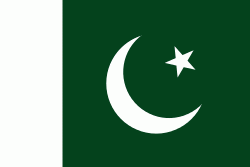Bajaur Agency (Bājaur Agency)
Bajaur District (باجوړ ولسوالۍ, ) is a district in Malakand Division of Khyber Pakhtunkhwa province in Pakistan. Until 2018, it was an agency of the Federally Administered Tribal Areas, then during restructuring that merged FATA with Khyber Pakhtunkhwa, it became a district. According to the 2017 census, the population of the district is 1,093,684. It borders Afghanistan's Kunar Province with a 52 km border. The headquarters of the agency administration is located in the town of Khar.
Bajaur is about 45 mi long by 20 mi broad. It lies at a high elevation to the east of the Kunar Valley of Afghanistan and Pakistan, from which it is separated by a continuous line of rugged frontier hills, forming a barrier that is easily passable at one or two points. The old road from Kabul to Pakistan ran through the barrier before the Khyber Pass was adopted as the main route. Nawagai is the chief town of Bajour; the Khan of Nawagai was previously under British protection for the purpose of safeguarding of the Chitral road.
To the south of Bajaur District is the wild mountain district of the Mohmand District. To the east, beyond the Panjkora River, are the hills of Swat District, dominated by another Pashtun group. To the north is an intervening watershed between Bajaur and the small tehsil of Dir. It is over this watershed and through the valley of Dir, that the new road from Malakand and the Punjab runs to Chitral.
An interesting feature in the topography is a mountain spur from the Kunar range.
The drainage of Bajaur flows eastwards, starting from the eastern slopes of the dividing ridge, which overlooks the Kunar and terminating in the Panjkora river, so that the district lies on a slope tilting gradually downwards from the Kunar ridge to the Panjkora.
Jandol, one of the northern valleys of Bajour, has ceased to be of political importance since the 19th century, when a previous chief, Umra Khan, failed to appropriate himself Bajour, Dir and a great part of the Kunar valley. It was the active hostility between the amir of Kabul (who claimed sovereignty of the same districts) and Umra Khan that led, firstly to the demarcation agreement of 1893 which fixed the boundary of Afghanistan in Kunar; and, secondly, to the invasion of Chitral by Umra Khan (who was no party to the boundary settlement), and the siege of the Chitral fort in 1895.
Bajaur is about 45 mi long by 20 mi broad. It lies at a high elevation to the east of the Kunar Valley of Afghanistan and Pakistan, from which it is separated by a continuous line of rugged frontier hills, forming a barrier that is easily passable at one or two points. The old road from Kabul to Pakistan ran through the barrier before the Khyber Pass was adopted as the main route. Nawagai is the chief town of Bajour; the Khan of Nawagai was previously under British protection for the purpose of safeguarding of the Chitral road.
To the south of Bajaur District is the wild mountain district of the Mohmand District. To the east, beyond the Panjkora River, are the hills of Swat District, dominated by another Pashtun group. To the north is an intervening watershed between Bajaur and the small tehsil of Dir. It is over this watershed and through the valley of Dir, that the new road from Malakand and the Punjab runs to Chitral.
An interesting feature in the topography is a mountain spur from the Kunar range.
The drainage of Bajaur flows eastwards, starting from the eastern slopes of the dividing ridge, which overlooks the Kunar and terminating in the Panjkora river, so that the district lies on a slope tilting gradually downwards from the Kunar ridge to the Panjkora.
Jandol, one of the northern valleys of Bajour, has ceased to be of political importance since the 19th century, when a previous chief, Umra Khan, failed to appropriate himself Bajour, Dir and a great part of the Kunar valley. It was the active hostility between the amir of Kabul (who claimed sovereignty of the same districts) and Umra Khan that led, firstly to the demarcation agreement of 1893 which fixed the boundary of Afghanistan in Kunar; and, secondly, to the invasion of Chitral by Umra Khan (who was no party to the boundary settlement), and the siege of the Chitral fort in 1895.
Map - Bajaur Agency (Bājaur Agency)
Map
Country - Pakistan
 |
 |
| Flag of Pakistan | |
Pakistan is the site of several ancient cultures, including the 8,500-year-old Neolithic site of Mehrgarh in Balochistan, the Indus Valley civilisation of the Bronze Age, the most extensive of the civilisations of the Afro-Eurasia, and the ancient Gandhara civilization. The region that comprises the modern state of Pakistan was the realm of multiple empires and dynasties, including the Achaemenid; briefly that of Alexander the Great; the Seleucid, the Maurya, the Kushan, the Gupta; the Umayyad Caliphate in its southern regions, the Hindu Shahis, the Ghaznavids, the Delhi Sultanate, the Mughals, the Durranis, the Omani Empire, the Sikh Empire, British East India Company rule, and most recently, the British Indian Empire from 1858 to 1947.
Currency / Language
| ISO | Currency | Symbol | Significant figures |
|---|---|---|---|
| PKR | Pakistani rupee | ₨ | 2 |
| ISO | Language |
|---|---|
| EN | English language |
| PA | Panjabi language |
| PS | Pashto language |
| SD | Sindhi language |
| UR | Urdu |















